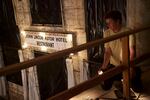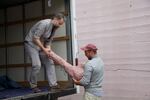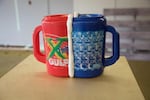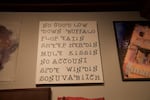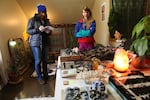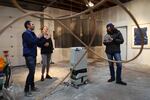
Michelle Grabner (right) and Disjecta's Taryn Wiens (center) visit artist Peter Simensky in studio.
April Baer / OPB
The mother of all summertime art road trips is here.
Disjecta's biennial show, Portland2016, has art on view in 13 cities, representing a dizzying range of Oregon contemporary art.
Last fall and winter, curator Michelle Grabner made a mind-bending 107 studio visits across the state. We tagged along with Grabner at several stages of her process.
Grabner is a well-known and respected figure in art circles in the Midwest. Her own artwork — in paint, enamel, paper or video — carries on a romance with pattern. She loves the look of textiles, bright ginghams and basket weaves. With her husband, Brad Killam, Grabner started a gallery space called the Suburban that’s been open for 16 years.
A prolific curator, academic at the Art Institute of Chicago, and essayist, she co-curated New York’s prestigious Whitney Biennial before agreeing to take on the Disjecta show. Here are a few highlights from our conversation:
Q&A with Michelle Grabner
April Baer: Why did you decide to take on the Portland Biennial, 2000 miles away from your home base in Milwaukee, Wisconsin?
Michelle Grabner: It goes back to my research for the Whitney Biennial in 2013 when I spent a couple days in Portland traveling up the coast, all the way from San Diego to Seattle, and I realized very quickly when I landed in Portland that I didn't have enough time earmarked here, so I realized that something would pull me back, and an invitation from Disjecta did just that.
Baer: You’ve had some experience with working outside the major hubs (New York, Los Angeles), having spent a lot of your career in Wisconsin and Chicago. What did that time do for you?
Grabner: Even Chicago to a certain degree, we think of it as a big center, and it is the center in the American interior. But it does evoke a second city syndrome. It's a very true thing where it will compare itself or want to compare itself to culturally overbuilt centers such as New York or Berlin or London or even Los Angeles to a certain degree.
For me as artist it was more interesting to have the freedoms of not working in the shadows of these vertical places, these vertical cultural hierarchies, and to be able to be critical of them, to push back. I was in school in the ‘80s and the ‘90s when institutional critique, the idea of poking at the authoritative cultural powers at play was prevalent — a responsibility as a critic and as an artist. Working in those freedoms, taking on those responsibilities and see what other kind of imaginations can come forward without those hierarchies in place.
Baer: Why was it important to look at artists across the state?
Grabner: It is the Portland Biennial, but that's a little confusing to some people and I spent some time explaining that when I was in a studio in Ashland. Disjecta often thinks of the Portland Biennial as being referential to the Venice Biennale. It's an international exhibition, so to some degree it's a state phenomenon. It's about Oregon and the state.
Baer: What did the studio visits do for you?
Grabner: Studio visits locate me in the space of making, so the artists will have not only the material of whatever they are dealing with, but in that space of making there is also language and it's really important to have this conversation with artists. So you have language as a means of communication, you have the scraps on floor, you have a studio desk full of materials, the landscape out the window. Walking through somebody's house through the backyard to their trailer in back, all of this is information and all of it is a way of coming to understand that artist's practice, their relationship to space, place, material, method, language, all of these things. You can't understand what an artist does through just straightforward exhibitions. You see the work, the artifact on the wall, but there is so much behind that. There is so much contextual information that is yielded from a studio visit. Not only does it tell you about that individual artist, but for me it helps me understand a contemporary condition of art making.
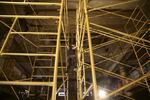
Artist Avantika Bawa scales "Mineral Spirit", the golden scaffolding that she spray painted and constructed in the Astor Hotel in Astoria for the biennial.
April Baer / OPB
Baer: Some biennials are selected with an eye to an idea about temporality, what’s going on right now. Is that something that informed what you were going for?
Grabner: Artists these days, particularly young artists, they may be influenced by someone from the 19th Century, they may be interested in contemporary literary artists, so it's so interesting how work comes together and where its influences lie or how influences are created. They are not a historical timeline anymore. Back to the immediacy of it, I think it's dangerous for artists to think about the immediacy of success of the here and now in 2016 because, first of all, as an artist you want to be making work when you're 65. That's the goal. All these contemporary markers that the art world holds out I think give a certain kind of anxiety and are a measure of success in the long run that I don't think help us.
Baer: What did you learn from the process co-curating the 2014 Whitney Biennial?
Grabner: It was the last Whitney Biennial in the Breuer building. The next Whitney Biennial will be next year in the [Renzo] Piano building in the meat packing district, so there is a whole different identity. It was unique. Here was a biennial where three curators each having a very specific and different piece of real estate in the institution, as opposed to kind of co-blending it. I learned a lot. It was probably the best education I had in my life. It was fascination to me in terms of power structure and how artists at work are very different. It's the Whitney Museum of American Art. What is American art? That institution is still in flux. I learned a lot about artists and high-pressure exhibitions. What was surprising to me was the fact that I was most disappointed in the critical response to the Whitney Biennial. It's always the same critical response. It is a response to the exhibition itself and the curators who had hand. What critics didn't do, and this disappoints me and is a plea actually for critics here in Oregon and in the Northwest: Actually do the hard work and look at the artists' work. I just hope the critics actually start thinking about what's happening at that level. For me that was a disappointment for the Whitney Biennial.
Baer: Your inclusion of Joe Scanlan ended up being at the center of a discussion about racial representation in the Whitney Biennial. I’ve heard you say that you wished the Whitney Biennial had been more overt in how it handled racial representation, that there had been involvement for that in the show. Why was that important to you?
Grabner: I think representation and diversity in contemporary art is an important conversation. It is happening everywhere in cities throughout the United States, it's happening on a global level, this is something defining in terms of who we are, and it needs to happen in the art world as well. There are the bean-counters out there that will just look at a list and count the number of women and break it down via gender or via race and that's all fine and good, but until we start having bigger conversations that are hosted by the institutions, it just becomes these numbers again, which doesn't do any good to any of us. It doesn't reflect who we are and the tensions that are very real within the world that we work.
Baer: Did racial representation inform what you were doing with the Portland Biennial?
Grabner: These are difficult conversations to have. Portland is Portland as a city. I've had many conversations about race, representation, about communities here and where they are, how they have been displaced. Those were conversations I was having when I first landed in Portland. For me, having a conversation and discourse is as important as balancing out with representation.
Baer: Do you want to tell us about what else you’ve been able to see and do while you’ve been in Oregon?
Grabner: I remember going back after my first visit, almost a year ago August. Going back and telling my husband, about the landscape and spending time and having great people at Disjecta take me into your most gorgeous landscape, and telling my husband that it's more spectacular than the Alps — and I've spent a lot of time in Switzerland recently. It's about the space and it's about the grandeur. Now (late June) I'm embedded in Bullseye as a resident artist. I as an artist have never applied to a residency before.
Baer: What did you make?
Grabner: My process is very different than artists who engage in art glass, which is very carefully considered and worked. It's about technique. It's about understanding what different temperatures can do to glass. I'm much more experimental. Tomorrow I open an exhibition at Seattle University that deals with the junk glass, the refuse, the glass that is not stable, that has not been in yield that comes out of the kiln. I really had to work hard and to talk the good people at Bullseye that this is valuable that this is an interesting sculptural work. I think I'm stretching Bullseye as much as they are stretching me.
Baer: Bullseye has been at the center of a very public debate about air quality and its methods. Did you have any trepidation about taking some time at their studios?
Grabner: I have come to know a lot of people here and on a regular basis when a news item would come out about Bullseye there were some people who were kicking that information to me. I was feeling as if I was put in a ethical dilemma. Whether I should say no until something happens or I should say yes. I'm so glad I'm there right now. I'm learning so much. The people who are there helping me out from both the factory to the upper administration to the production side of things. Not only generous in terms of material supplies and information, but also talking through what it means to be a site of controversy and where the truth lies and where the dangers actually lie. That's being worked out both legally and in the collection of moss by your forestry department and trying to look at the particles in the air. There's a bit of a parallel to what you are asking me about in terms of race and representation. As somebody from the outside trying to as objectively as possible understand what is going on, but also understanding the political influences from deep within Portland.

